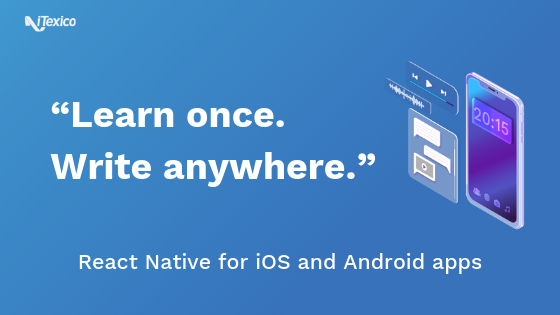Understanding React Native Apps 101
One can only imagine the feeling of exhilaration when the Golden Gate Bridge in San Francisco opened to the public. After spending centuries waving at each other, people on both sides of the waterway now had an easy and efficient way to get closer. No more swimming across the bay or taking a long way around.
Today, mobile app developers and engineers are experiencing the same sense of excitement around React Native – a new way to develop mobile applications that deliver a finished product for both iOS and Android at the same time...
What Is React Native?
The React Native framework -- originally based on Facebook’s Javascript Library -- uses JavaScript and React.js components to build mobile user interfaces that work on multiple platforms.
No more coding, and recoding, to get an app working on both dominant mobile app platforms – or, worse, making the cost-cutting decision to develop for one platform, and not the other.
Is React Native Cross-Platform?
By choosing a Javascript-only standard, React Native bypasses the normal barriers that prevent a single purpose-built mobile app from working on multiple platforms. Apps written in React Native, as the name suggests, render natively on both iOS and Android platforms. All you need to do is create the code in JavaScript and make minor adjustments to ensure it fits the UI of your selected platform. The code is then rendered to iOS and Android code providing a native look and feel.
This ultimately saves valuable development time and generates better development experience, as a developer can create one code base that will fit any platform, as a cross platform development without needing to learn iOS and Android programming languages.
Little wonder that React Native’s tagline is, “Learn once. Write anywhere.”
How Can React Native Application be Important to Businesses?
Thanks to its time-saving flexibility, React Native has quickly gained favor and popularity among mobile app development shops. Businesses no longer are faced with the decision of focusing on iOS or Android to develop better native features and mobile app development.
By creating a single framework that functions simultaneously, upon release, for both platforms, companies can efficiently deploy mobile apps while saving time, money and resources. Further, since React Native is UI-focused, app users will enjoy streamlined loading times and an overall smoother function.
Who is Currently Using React Native?
React Native isn’t just a hit with small and mid-market companies looking to be cost efficient. Because React Native apps are launched and maintained more quickly than its counterparts, it has gained favor with some of the biggest enterprises in the business, including:
- Skype
- Airbnb
- Tesla
- Walmart
- Bloomberg
- UberEATS
- Vogue
React Native Pros and Cons
What are the Pros of Using React Native Apps
Let’s dig deeper into the benefits of React Native as a next-gen app-building ally:
-
It Improves Time Efficiency: React Native uses “hot reloading,” a feature that allows changes made in the code to immediately take effect on both iOS and Android platforms. According to an article in Facebook.github.io, the purpose of hot reloading in React Native is to keep the app running while the developer injects new versions of the files that were edited at runtime. This can be useful for developers who are actively pushing tweaks to the UI. React Native’s library of code is also impressive, offering ready-to-apply components. This means, according to Medium.com, “instead of writing code from scratch, [developers] can get to use ready-made components. They are great for achieving simple forms of functionalities. It not only makes the development process simple but also faster.”
-
It Increases Performance: Unlike other development frameworks, React Native has no lag time as it works on both platforms and includes a faster ability to reuse components with little to no maintenance involved. The secret to this performance improvement lies in React Native’s use of native APIs. According to Medium.com, when rendering code in this manner, independently and directly, “it uses a separate thread from UI, which results in increased performance.”
-
You’ll Join a Strong Collaborative Community: As an open-sourced project, React Native relies on its community to grow, improve, and increase its relevance. Any developer can contribute to the framework and can get help from the community with any issues that they are currently facing. One key benefit to being open-source: According to Thinkwik, it could ensure React Native-built mobile apps are compatible with other future-forward operating systems, including Apple’s tvOS and even Windows.
-
It Reduces Costs: The lightweight, Javascript-centric React Native platform requires very little code to create apps targeting multiple OS. This approach is proven to be cost-effective, as businesses don’t need to hire separate teams for different development projects. As previously mentioned, while using React Native, one developer can code for two platforms, which consumes fewer resources reduces the length of development cycles with pretty impressive native components.
-
It’s Reliable and Stable: By simplifying data binding, React Native offers the added benefit of ensuring that child elements cannot affect parent data. This leads to the production of mobile apps that are inherently reliable and stable. According to Medium.com, “if the developer wants to change an object, he/she would have to modify its state and apply updates accordingly – meaning only allowed components will be upgraded.” Further proof of React Native’s stability can be drawn from its impressive list of users – if Facebook, Instagram, Airbnb, Skype put their trust in React Native, it speaks volumes to the quality of the output.
“If the developer wants to change an object, he/she would have to modify its state and apply updates accordingly – meaning only allowed components will be upgraded.”
Hand-Picked Related Reads For You

Unleashing Business Innovation Through Enterprise Mobile Apps
READ MORE

Progressive Web Apps 101 & Why They’ll Replace Native Mobile Apps
READ MORE

How to Plan and Execute Your Mobile Strategy
READ MORE
What are the Cons of Using React Native Apps
As universally appealing as it may seem, React Native may not yet be the “killer app” for everybody. Here are some important considerations to bear in mind:
-
It Has a Small Component Pool: Key to React Native’s efficiency is its simplicity. Developers are encouraged to build UI using ready-made components. While offering huge time-saving benefits, some developers may find the pool of components small and limiting. This will likely change over time, but currently, more complex projects may best be developed on other platforms.
-
Component Quality Will Vary: As these component libraries have been derived through third-party developers, quality may vary, and bugs might proliferate. This could force developers to pore over lines of code to correct some of these bugs -- defeating the purpose of switching over to React Native. As its evolution is occurring at light speed, React Native may, at times, move too fast for components to keep up. When an update occurs, the third-party libraries will often get outdated. Developers will have to eventually wait for the third-party libraries to catch up with these updates.
-
There is a Steep Learning Curve: Surprising, React Native might actually be a more complex undertaking for developers not accustomed to working in JSX. According to Alan Blog, “the JSX is a JavaScript syntax extension that allows mixing HTML with JavaScript. It doesn’t come that naturally to the average person and has a steep learning curve, which can be frustrating.”
-
Security with a JavaScript-Based Library: Javascript has long been derided for its fragile nature – this means that developers coding in React Native will need to invest additional effort to ensure the security of the code base. According to Citrusbits.com, “since third-party component libraries are shared, developers need to keep a close eye on malicious snippets that could potentially harm their app’s core functionality.
React Native is a necessity for enterprises looking to speed their mobile app development projects to completion.
So, is React Native right for your mobile app project? Offering universal appeal and time-saving leaps forward in development resources.





Post Your Comment Here